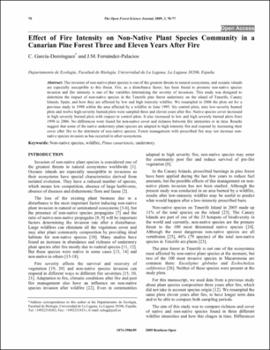Effect of fire intensity on non-native plant species community in a Canarian pine forest three and eleven years after fire
Fecha
2009Resumen
The invasion of non-native plant species is one of the greatest threats to natural ecosystems, and oceanic islands
are especially susceptible to this threat. Fire, as a disturbance factor, has been found to promote non-native species
invasion and fire intensity is one of the variables determining the severity of invasions. This study was designed to
determine the impact of non-native species in the Tenerife pine forest understory on the island of Tenerife, Canary
Islands, Spain, and how they are affected by low and high intensity wildfire. We resampled in 2006 the plots set for a
previous study in 1998 within the area affected by a wildfire in June 1995. Six control plots, nine low-severity burned
plots and twelve high-severity burned plots were sampled three and eleven years after fire. Native species cover increased
in high severely burned plots with respect to control plots. It also increased in low and high severely burned plots from
1998 to 2006. No differences were found for non-native cover and richness between fire intensities or in time. Results
suggest that some of the native understory plant species are adapted to high intensity fire and respond by increasing their
cover after fire to the detriment of non-native species. Forest management with prescribed fire may not increase nonnative
species invasion as has occurred in other ecosystems.






